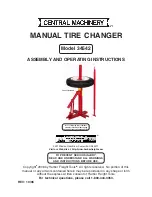
- 23 -
9.3
General Formulas Use for Estimation
The example below calculates the braking torque and the discharging resistance of a motor for
traveling machine.
(1) Rated motor torque T
M
(N.m)
P
M
N
M
T
M
= 9550
×
where
P
M
: Rated capacity of the motor (kW)
N
M
: Rated revolutions per minutes of the motor (r.p.m.)
(2) Braking torque (required to decelerate) T
B
(N.m)
* While this value is negative, only the inverter can brake the motor. (The BRD is not
required.)
−
T
L
J
×
(N
1
−
N
2
)
9.55
×
t
B
T
B
=
where
J
:
Moment of inertia of the motor and the load (converted to motor shaft) (kg.m
2
)
N
1
, N
2
: Rotational speed (r.p.m.) before deceleration and rotational speed (r.p.m.) after
deceleration
T
L
:
Load torque (converted to motor shaft) (N.m)
t
B
:
Deceleration time (seconds)
(3) Discharging resistance R (ohms): Resistance relative to the inverter
* If this value is under the minimum value of a BRD, two or more BRDs are required.
0.105
×
T
B
×
N1
×
R =
1
V
on
2
1.2
where
V
on
:
BRD operating voltage (362.5 V for the 200V class or 725V for the 400V class)
(4) Mean discharging capacity PL (W)
* The capacity of the discharging resistor should be 2.5 to 3 times the result of the formula
below.
2
×
P
L
=
0.105
×
(T
B
−
0.2
×
T
M
)
×
(N
1
+ N
2
)
t
C
t
B
where
t
C
:
Operation cycle(s)
(5) Duty cycle
t
B
/
t
C
‡ @
The duty cycle (
t
B
/
t
C
) for the discharging resistor I is as follow:
• …
EZ2-30K:
t
C
t
B
5
1
• …
t
C
t
B
10
1
‡ A
The dynamic braking unit can be used continuously for the use of the discharging
resistor II.
* See 9.3 (4) for capacities of the discharging resistors.
* See Table 7.1 for details of the discharging resistors I and II.
(6) Thermal set value
2
÷
Resistance of the discharging resistor (
Ω
)
÷
1.2
Thermal set value (A)
‡ •
Rated capacity of the discharging resistor (W)
* This is a reference value for enameled and ribbon resistors.





































